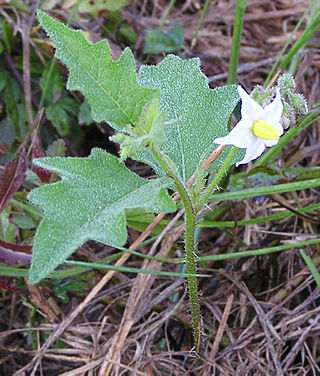
Solanum carolinense, the Carolina horsenettle, is not a true nettle, but a member of the Solanaceae, or nightshade family. It is a perennial herbaceous plant, native to the southeastern United States, though its range has expanded throughout much of temperate North America. The plant is an invasive in parts of Europe, Asia, Africa and Australia. The stem and undersides of larger leaf veins are covered with prickles.

The New River is a river which flows through the U.S. states of North Carolina, Virginia, and West Virginia before joining with the Gauley River to form the Kanawha River at the town of Gauley Bridge, West Virginia. Part of the Ohio River watershed, it is about 360 miles (580 km) long.

Metaxaglaea is a genus of moths of the family Noctuidae.
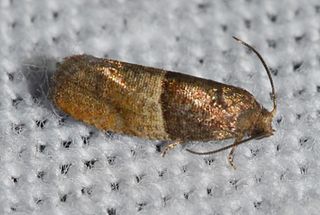
Larisa is a genus of moths belonging to the subfamily Olethreutinae of the family Tortricidae. It contains only one species, Larisa subsolana, which is found in North America, where it has been recorded from Alabama, Florida, Georgia, Illinois, Indiana, Kentucky, Maine, Maryland, Massachusetts, Minnesota, Mississippi, Missouri, New York, Ohio, Oklahoma, Ontario, Quebec, South Carolina, Tennessee, Texas, Virginia, and West Virginia.

Cecrita guttivitta, the saddled prominent moth, is a species of moth of the family Notodontidae. It is found in North America, including Alabama, Arkansas, Connecticut, Delaware, Florida, Georgia, Illinois, Indiana, Iowa, Kansas, Kentucky, Maine, Maryland, Massachusetts, Minnesota, New Brunswick, New Hampshire, New Jersey, New York, North Carolina, Ohio, Oklahoma, Ontario, Pennsylvania, South Carolina, Tennessee, Vermont, Virginia, West Virginia and Wisconsin.
Spilosoma latipennis, the pink-legged tiger moth, or the red-legged diacrisia, is a moth in the family Erebidae. It was described by Richard Harper Stretch in 1872. It is found in eastern North America, where it has been recorded from Georgia, Indiana, Iowa, Kansas, Kentucky, Maine, Maryland, New Brunswick, New York, North Carolina, Ohio, Ontario, Pennsylvania, South Carolina, West Virginia and Wisconsin.

Diacme adipaloides, the darker diacme moth, is a moth in the family Crambidae. It was described by Augustus Radcliffe Grote and Coleman Townsend Robinson in 1867. It is found in North America, where it has been recorded from Alabama, Arkansas, Florida, Indiana, Maine, Maryland, Massachusetts, Michigan, Minnesota, New Brunswick, New Hampshire, New Jersey, New York, North Carolina, Nova Scotia, Ohio, Oklahoma, Ontario, Quebec, South Carolina, Tennessee, Texas, Virginia, West Virginia and Wisconsin. Adults have been recorded year round.

Arogalea cristifasciella, the stripe-backed moth, is a moth of the family Gelechiidae. It is found in North America, where it has been recorded from Alabama, Arkansas, Connecticut, Florida, Georgia, Illinois, Indiana, Kansas, Kentucky, Louisiana, Maine, Maryland, Massachusetts, Michigan, Mississippi, Missouri, New Hampshire, New Jersey, New York, North Carolina, Ohio, Oklahoma, Ontario, Quebec, South Carolina, Tennessee, Texas, Virginia, West Virginia and Wisconsin.

Dichorda iridaria, the showy emerald moth, is a moth of the family Geometridae. The species was first described by Achille Guenée in 1857. It is found in North America, where it has been recorded from Alabama, Arkansas, Florida, Georgia, Illinois, Indiana, Iowa, Kentucky, Maryland, Massachusetts, Mississippi, New Hampshire, New Jersey, New York, North Carolina, Ohio, Oklahoma, Ontario, Pennsylvania, Quebec, South Carolina, Tennessee, Texas, Virginia, West Virginia and Wisconsin.

Elaphria grata, the grateful midget moth, is a moth of the family Noctuidae. It is found in North America, where it has been recorded from Alabama, Arkansas, Connecticut, Delaware, Florida, Georgia, Illinois, Indiana, Iowa, Kansas, Kentucky, Maine, Maryland, Massachusetts, Mississippi, Missouri, New Jersey, New York, North Carolina, Ohio, Oklahoma, Ontario, Pennsylvania, South Carolina, Tennessee, Texas, Virginia, West Virginia and Wisconsin.
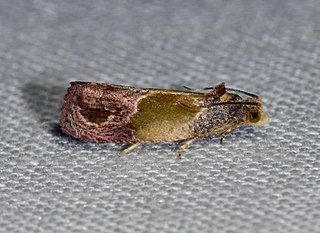
Eumarozia malachitana, the sculptured moth, is a species of moth of the family Tortricidae. It is found in eastern North America, where it has been recorded from Alabama, Arkansas, California, Florida, Georgia, Illinois, Indiana, Iowa, Kentucky, Louisiana, Maine, Maryland, Massachusetts, Minnesota, Mississippi, Missouri, New Jersey, North Carolina, Ohio, Oklahoma, Ontario, Pennsylvania, South Carolina, Tennessee, Texas, Virginia and West Virginia.

Gymnandrosoma punctidiscanum, the dotted ecdytolopha moth, is a moth of the family Tortricidae. It is found in North America, where it has been recorded from Alabama, Arkansas, Florida, Georgia, Illinois, Indiana, Kentucky, Maine, Maryland, Massachusetts, Michigan, Minnesota, Missouri, New Jersey, New York, North Carolina, Ohio, Oklahoma, Ontario, Pennsylvania, Quebec, South Carolina, Tennessee, Virginia, and West Virginia.

Hyperstrotia secta, the black-patched graylet moth, is a moth of the family Erebidae. The species was first described by Augustus Radcliffe Grote in 1879. It is found in North America, where it has been recorded from Alabama, Arkansas, Florida, Georgia, Illinois, Indiana, Kentucky, Louisiana, Maryland, Massachusetts, Mississippi, New Hampshire, New Jersey, New York, North Carolina, Ohio, Oklahoma, South Carolina, Tennessee, Virginia and West Virginia.

Metalectra tantillus, the black fungus moth, is a moth of the family Erebidae. The species was first described by Augustus Radcliffe Grote in 1874. It has been recorded from the US states of Alabama, Florida, Georgia, Illinois, Iowa, Kentucky, Maryland, Mississippi, New Jersey, North Carolina, Ohio, Oklahoma, Pennsylvania, South Carolina, Tennessee, Texas, West Virginia and Wisconsin.

Pococera expandens, the striped oak webworm moth or double-humped pococera moth, is a moth of the family Pyralidae. It is found in North America, where it has been recorded from Arizona, Arkansas, British Columbia, Georgia, Illinois, Indiana, Iowa, Kentucky, Louisiana, Maine, Manitoba, Maryland, Massachusetts, Mississippi, New Brunswick, New Hampshire, New Jersey, New York, North Carolina, Ohio, Oklahoma, Ontario, Pennsylvania, Quebec, South Carolina, Tennessee, Texas, Virginia, West Virginia and Wisconsin.
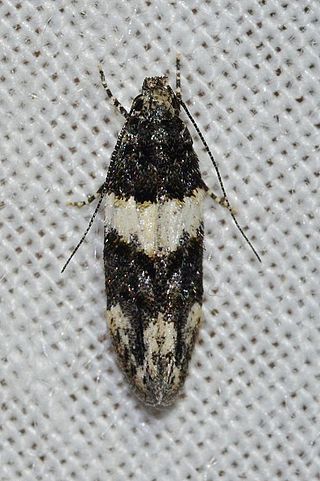
Pubitelphusa latifasciella, the white-banded telphusa moth, is a moth of the family Gelechiidae. It is found in North America, where it has been recorded from Alabama, Arkansas, Florida, Georgia, Illinois, Indiana, Kansas, Kentucky, Louisiana, Maryland, Minnesota, Mississippi, Missouri, New Jersey, New York, North Carolina, Ohio, Oklahoma, Ontario, Quebec, South Carolina, Tennessee, Texas, Virginia, West Virginia and Wisconsin.

Polygrammodes flavidalis, the ironweed root moth, is a moth in the family Crambidae. It is found in North America, where it has been recorded from Alabama, Florida, Georgia, Illinois, Indiana, Iowa, Kansas, Kentucky, Maryland, Mississippi, Missouri, New Jersey, North Carolina, Ohio, Oklahoma, Ontario, Pennsylvania, South Carolina, Tennessee, Texas, Virginia, West Virginia and Wisconsin.
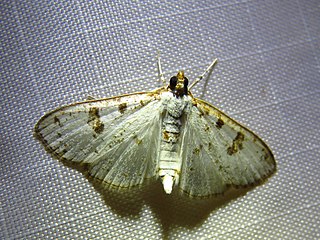
Palpita illibalis, the inkblot palpita moth, is a moth in the family Crambidae. It was described by Jacob Hübner in 1818. It is found in North America, where it has been recorded from Alabama, Florida, Georgia, Maryland, Mississippi, North Carolina, Ohio, Oklahoma, Pennsylvania, South Carolina, Tennessee, Virginia and West Virginia.
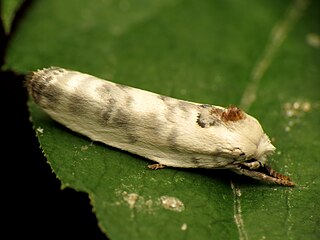
Antaeotricha leucillana, the pale gray bird-dropping moth, is a moth in the family Depressariidae. It was described by Philipp Christoph Zeller in 1854. It is found in North America, where it has been recorded from New Hampshire, Massachusetts, New York, Pennsylvania, District of Columbia, Virginia, North Carolina, Georgia, Alabama, Arkansas, Missouri, Kansas, Illinois, Iowa, Texas, Oregon, Louisiana, Manitoba and Nova Scotia.
Metaxaglaea australis, the southern sallow moth, is a species of cutworm or dart moth in the family Noctuidae. It is found in North America.


















